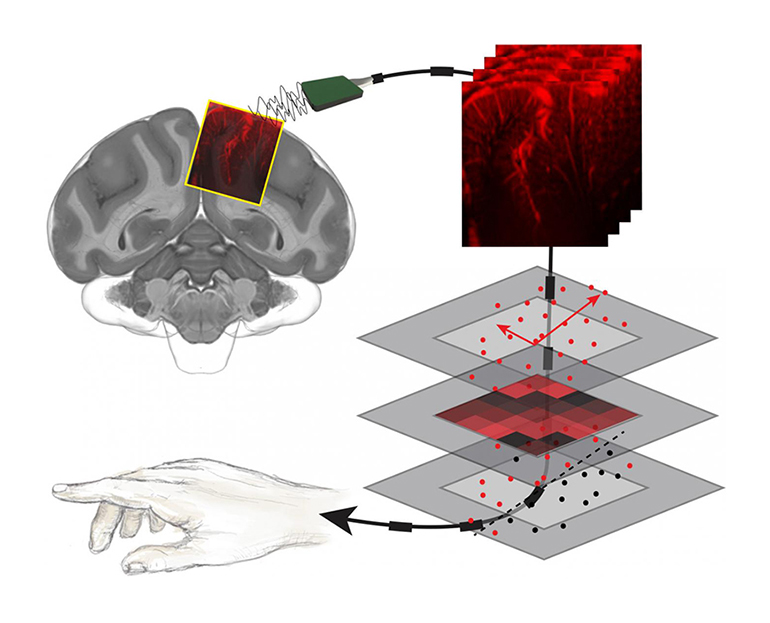

Researchers have developed a non-invasive functional ultrasound system that can detect brain activity by listening to tiny changes in blood flow within the brain. The system provides a viable alternative to invasive electrodes that are implanted into it for brain machine interfaces, such as those used in prosthetics. So far, the system can detect the activity of brain corresponding to a specific body movement in non-human primates, before the movement occurs.
Brain machine interfaces hold significant promise for those with paralysis in controlling a variety of assistive technologies, such as wheelchairs and prosthetic devices. However, the need to implant electrodes may give many pause for thought.
This latest study has shown that functional ultrasound may be a viable alternative.
“Invasive forms of brain-machine interfaces can already give movement back to those who have lost it due to neurological injury or disease,” said Sumner Norman, a researcher involved in the study, in a Caltech announcement. “Unfortunately, only a select few with the most severe paralysis are eligible and willing to have electrodes implanted into their brain.
Functional ultrasound is an incredibly exciting new method to record detailed brain activity without damaging brain tissue. We try to push the limits of ultrasound neuroimaging and were thrilled that it could predict movement. What’s most exciting is that functional ultrasound is a young technique with huge potential – this is just our first step in bringing high performance, less invasive BMI to more people.”

The new technique involves implanting a small ultrasound-transparent window in the skull (here’s an example), which is significantly less invasive than directly implanted electrodes. The ultrasound signals can then non-invasively pass into it and identify increases in blood flow in specific the regions. So far, the technology tests in its potential to help decode intentions to move in non-human primates.
“The first milestone was to show that ultrasound could capture signals related to the thought of planning a physical movement,” said David Maresca, another researcher involved in the study. “Functional ultrasound imaging manages to record these signals with 10 times more sensitivity and better resolution than functional MRI. This finding is at the core of the success of brain-machine interfacing based on functional ultrasound.”
more recommended stories
 Phage Therapy Study Reveals RNA-Based Infection Control
Phage Therapy Study Reveals RNA-Based Infection ControlKey Takeaways (Quick Summary) Researchers uncovered.
 Safer Allogeneic Stem Cell Transplants with Treg Therapy
Safer Allogeneic Stem Cell Transplants with Treg TherapyA new preclinical study from the.
 AI in Emergency Medicine and Clinician Decision Accuracy
AI in Emergency Medicine and Clinician Decision AccuracyEmergency teams rely on rapid, accurate.
 Innovative AI Boosts Epilepsy Seizure Prediction by 44%
Innovative AI Boosts Epilepsy Seizure Prediction by 44%Transforming Seizure Prediction in Epilepsy Seizure.
 Hypnosis Boosts NIV Tolerance in Respiratory Failure
Hypnosis Boosts NIV Tolerance in Respiratory FailureA New Approach: Hypnosis Improves NIV.
 Bee-Sting Microneedle Patch for Painless Drug Delivery
Bee-Sting Microneedle Patch for Painless Drug DeliveryMicroneedle Patch: A Pain-Free Alternative for.
 AI Reshapes Anticoagulation in Atrial Fibrillation Care
AI Reshapes Anticoagulation in Atrial Fibrillation CareUnderstanding the Challenge of Atrial Fibrillation.
 Hemoglobin as Brain Antioxidant in Neurodegenerative Disease
Hemoglobin as Brain Antioxidant in Neurodegenerative DiseaseUncovering the Brain’s Own Defense Against.
 Global Data Resource for Progressive MS Research (Multiple Sclerosis)
Global Data Resource for Progressive MS Research (Multiple Sclerosis)The International Progressive MS Alliance has.
 AI Diabetes Risk Detection: Early T2D Prediction
AI Diabetes Risk Detection: Early T2D PredictionA new frontier in early diabetes.

Leave a Comment